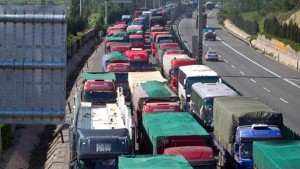And you thought your commute was bad? Even traveling the notorious I-405 corridor in Los Angeles is a snap compared to what motorists are facing on the G-110, a limited access highway leading into Beijing, where a monstrous, 60-mile traffic jam is now in its 12th day.
According to news reports out of the People’s Republic, it has been taking travelers as much as five days to work their way from one end of the snarl to the other, and at this point there appears to be no end in sight – quite literally.
While Chinese traffic has grown steadily worse, in recent years, as more and more of the emerging middle class purchases automobiles, no one seems to have a clear explanation for why G-110 has ground to a complete halt. But the Christian Science Monitor is reporting that the National Highway is overloaded with truck drivers carrying coal for the country’s energy-hungry capital – much of it illegal.
Complicating matters, there’s construction around Beijing limiting access to other roadways that might normally be used to divert some of the traffic.
The situation, according to Chinese reports, could be more the norm than the exception for the next three to four years, until new rail lines that will take coal shipments off the highway are completed. A similar tie-up recently ran on for a full month.
China depends on coal for up to 70% of its energy – despite efforts to diversify with such efforts as the Three Rivers hydro-electric project. Complicating matters, the country has belatedly responded to its heavy annual toll of mining accidents, which typically take more than 10,000 lives annually, by closing some of the most dangerous coal mines, in Shangxi Province.
That means trucks from replacement sources, in Inner Mongolia, must head for Beijing on one of several heavily-traveled routes into the capital. But so do drivers carrying coal from illegal mines. And the G-110 is preferred because of its low tolls and limited coal truck inspection stations.
China is now the largest automotive market in the world, surpassing the recession-plagued U.S. in 2008. But like the booming economy itself, the demand for new cars is primarily centered in a “fertile crescent” that curves along the country’s Pacific coast. That means massive problems for cities like Beijing and Shanghai.
Of course, China’s not alone. Western nations have long had to cope with traffic problems. But the shift of wealth to a handful of emerging nations – often known as the BRIC countries, for Brazil, Russia, India and China – is happening so quickly, with demand for automobiles booming seemingly overnight, that traffic problems are reaching levels never before seen.
Moscow has, on the whole, what is considered to be the worst traffic of any city in the world, right now. A recent article in the New Yorker described a scene earlier this year in which patients being transferred to hospitals died in ambulances that were caught up in traffic for hours on end.
Like Beijing, Russia’s capital is investing massive sums of tax dollars into the effort to keep up. It is working on a third ring road around the city, and looking for ways to beef up mass transit. But even though Russian car sales have been in the doldrums for the last two years, few expect that city’s traffic problems to clear up soon.

